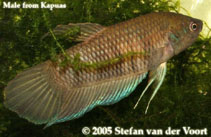| Family: |
Osphronemidae (Gouramies), subfamily: Macropodusinae |
| Max. size: |
7.91 cm SL (male/unsexed) |
| Environment: |
benthopelagic; freshwater |
| Distribution: |
Asia: Indonesia. |
| Diagnosis: |
Dorsal spines (total): 1-1; Dorsal soft rays (total): 8-8; Anal spines: 2-2; Anal soft rays: 26-27; Vertebrae: 31-32. Fewer total anal rays than B. balunga (28-29 versus 30). More lateral scales than B. balunga and B. chini (31 1/2-32 1/2 versus 29-31). More lateral scales below dorsal-fin origin (18-19, versus 15-18). Greater total length than B. balunga and B. chini (145.5-153.5% SL, versus 132.8-144.6). Shorter head length than B. balunga (31.3-31.7% SL versus 32.6-35.5). Deeper body depth at dorsal-fin origin than B. akarensis and B. chini (30.6-31.6% SL versus 25.1-30.9). Shorter preanal length than B. balunga (44.7-46.3% SL versus 49.2-52.2). It has the most pigmented opercle pattern with a darkly pigmented opercle distal edge and many spots (more than 7 versus 5 or less, or stripes) (Ref. 30224). |
| Biology: |
Occurs in forest streams with slow current and swamp forest, in shore vegetation and leaf litter (Ref. 56749). |
| IUCN Red List Status: |
Critically Endangered (CR); Date assessed: 25 December 2018 (B2ab(iii,v)) Ref. (130435)
|
| Threat to humans: |
harmless |
Source and more info: www.fishbase.org. For personal, classroom, and other internal use only. Not for publication.

